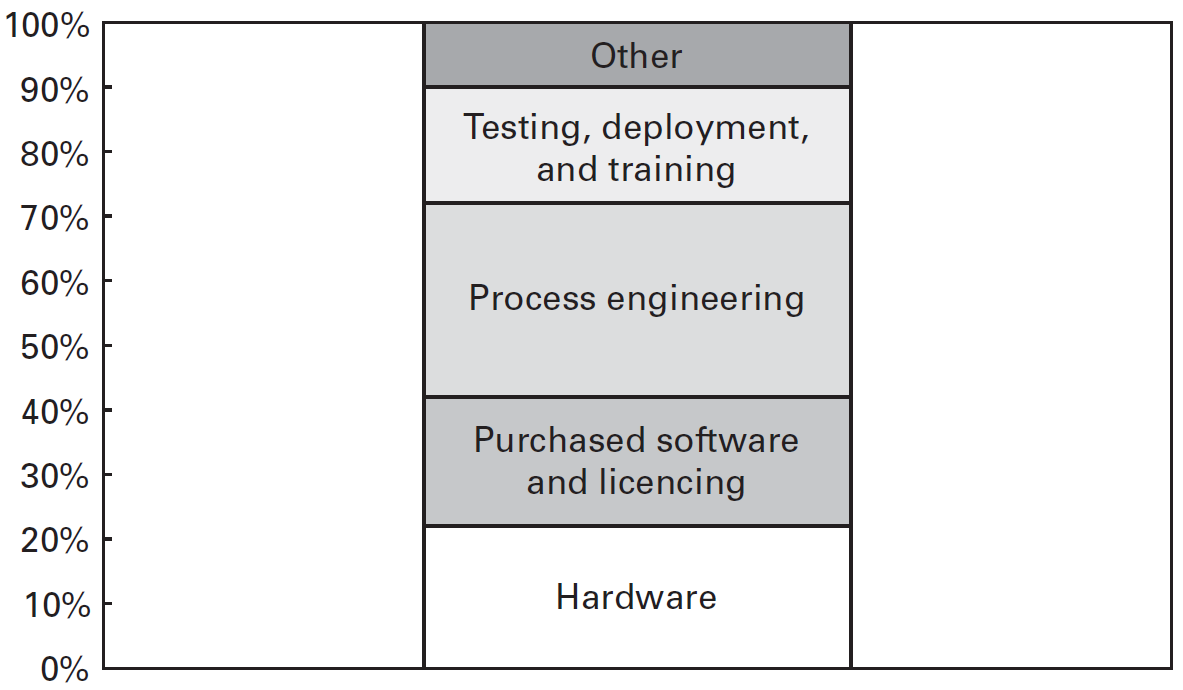
Cost breakdown of initial projects to implement new information technology in large manufacturing firms. The IT investment is just a part, and the total project is just a part, of developing IT-enabled process improvements.
IT-enabled process improvements show that IT is a general-purpose technology
…criteria for a general-purpose technology…
- wide scope for improvement and elaboration
- applicability across a broad range of uses
- potential for use in a wide variety of products and processes
- strong complementarities with existing or potential technologies.
…David… described the invention of the dynamo and its effect on the organization of the factory. …decades passed before factories reorganized themselves internally and made truly significant productivity gains possible.
Bresnahan and Trajtenberg… developed a model of the use of semiconductors as a general-purpose technology, characterized by “pervasiveness, inherent potential for technical improvements, and ‘innovational complementarities’”… On one level, computing invention-possibility can make existing processes run faster.
…a more exciting use of computing would be to push out the frontier. Computing can change the way business is done. …we believe that there are decades’ worth of potential innovations to be made by creatively combining inventions that we already have in creative ways.
IT-enabled process improvements use hard-to-value capabilities to generate, in part, hard-to-value results
…the literature agrees on one basic point: the size of the total stock of intangible capital in the United States is very large—as much as several trillion dollars. Often this capital does not show up in balance sheets or economic figures, either in government accounts or as an item in firm-level balance sheets.
If we used consumer surplus data to examine the effects of technological innovation over the decades, we would find hundreds of billions, perhaps trillions of dollars of unmeasured benefits in the economy.
Although decreasing communications costs have been affecting incentives for innovation for centuries, free and perfect copies that are easy to distribute were never possible until recently. But the Internet, so far, has not killed innovation. Rather, it has created an entire generation of individual innovators. If history is any guide, the Internet will encourage vast amounts of innovation.
IT-enabled process improvements led by the United States are increasing productivity
…IT is playing an important role in the US productivity resurgence since 1995, and… something unique is occurring in the United States.
The further productivity acceleration since 2001 in the absence of substantial investments in IT remains a subject of debate in the literature. …our hypothesis is that firms benefited from the organizational capital that they built at the end of the 1990s. That is, there may be a lag of approximately 3 or 4 years before the process improvements to IT appear in the productivity statistics.
Major empirical and case studies from the period 1995– 2008 point to business-process reorganization as a major factor in explaining productivity differences across plants or firms.
IT-enabled process improvements have come from seven practices
…the firms that simultaneously invested in IT and in the practices did disproportionately better than firms that did only one or the other. In other words, the practices are complementary to IT investment.
- Move from analog to digital processes
Moving an increasing number of processes into the paperless, digital realm… - Open information access
Digital organizations… encourage the use of dispersed internal and external information sources. - Empower the employees
Digital organizations decentralize authority—pushing decision rights to those with access to information. - Use performance-based incentives
Meritocratic pay structures, incentive pay for individuals and groups, and stock options are common at digital organizations. - Invest in corporate culture
Part of making productive use of IT is to define and promote a cohesive set of high-level goals and norms that pervade the company. - Recruit the right people
The fact that technology gives employees more information and authority implies that such employees need to be more capable… - Invest in human capital
…digital organizations provide more training… Many of the changes… call for increased levels of thinking and ingenuity on the part of employees.[1]
- Brynjolfsson, Erik, and Adam Saunders. Wired for innovation: how information technology is reshaping the economy. MIT Press, 2009.